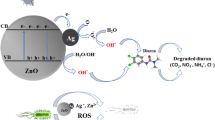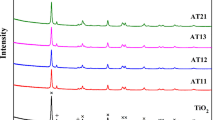Abstract
A method of solution impregnation and calcination has been demonstrated for synthesizing nanoparticles of Ag–TiO2 composite photocatalysts for use in the disinfection of water. Only a small proportion of the TiO2 surface is covered by nano-islands of Ag corresponding to a loading of 4 wt.% of Ag; thus, most of the TiO2 surface is available for photocatalytic function. Although the primary particles of both Ag and TiO2 are in the 10- to 20-nm range, microscopic studies indicate that the primary particles of Ag are deposited on nano-agglomerates of 30- to 70-nm-sized TiO2. It is seen that the relatively small loading of Ag has not caused any UV–vis spectral shift but has enhanced the rate of photocatalytic antibacterial action of TiO2, presumably by electron trapping.











Similar content being viewed by others

References
Rijal GK, Fujioka RS (2001) Synergistic effect of solar radiation and solar heating to disinfect drinking water sources. Water Science Technol 43(12):155–162
Burch J, Thomas K (1998) Water disinfection for developing countries and potential for solar thermal pasteurization. Sol Energy 64(1–3):87–97
Wist J, Sanabria J, Dierolf C, Torres W, Pulgarin C (2002) Evaluation of photocatalytic disinfection of crude water for drinking-water production. J Photochem Photobiol A: Chem 147:241–246
Makowski A, Wardas W (2001) Photocatalytic degradation of toxins secreted to water by cyanobacteria and unicellular algae and photocatalytic degradation of the cells of selected microorganisms. Curr Top Biophys 25(1):19–25
Chatterjee S, Sarkar S, Bhattacharyya SN (1993) Size effect in the photochemical generation of hydrogen from water by colloidal Fe2O3 particles. J Photochem Photobiol A: Chem 72:183–187
Chatterjee S, Sarkar S, Bhattacharyya SN (1994) Photodegradation of phenol by visible light in the presence of colloidal Fe2O3. J Photochem Photobiol A: Chem 81:199–203
Djebbar K, Sehili T (1998) Kinetics of heterogeneous photocatalytic decomposition of 2,4-dichlorophenoxyacetic acid over titanium dioxide and zinc oxide in aqueous solution. Pestic Sci 54:269–276
Seven O, Dindar B, Aydemir S, Metin D, Ozinel MA, Icli S (2004) Solar photocatalytic disinfection of a group of bacteria and fungi aqueous suspensions with TiO2, ZnO and Sahara desert dust. J Photochem Photobiol A: Chem 165:103–107
Rincon AG, Pulgarin C, Adler N, Peringer P (2001) Interaction between E. coli inactivation and DBP—precursors—dihydroxybenzene isomers—in the photocatalytic process of drinking-water disinfection with TiO2. J Photochem Photobiol A: Chem 139:233–241
Rincon AG, Pulgarin C (2004) Field solar E. coli inactivation in the absence and presence of TiO2: is UV solar dose an appropriate parameter for standardization of water solar disinfection. Sol Energy 77(5):635–648
Slawson RM, Van Dyke MI, Lee H, Trevors JT (1992) Germanium and silver resistance, accumulation, and toxicity in microorganisms. Plasmid 27(1):72–79
Zhao GJ, Stevens SE (1998) Multiple parameters for the comprehensive evaluation of the susceptibility of Escherichia coli B to the silver ion. BioMetals 11:27–32
Sondi I, Salopek-Sondi B (2004) Silver nanoparticles as antimicrobial agent: a case study on E. coli as a model for Gram-negative bacteria. J Colloid Interface Sci 275:177–182
Dowling DP, Betts AJ, Pope C, McConnell ML, Eloy R, Arnaud MN (2003) Anti-bacterial silver coatings exhibiting enhanced activity through the addition of platinum. Surf Coat Technol 163–164:637–640
Jin M, Zhang X, Nishimoto S, Liu Z, Tryk DA, Emeline AV, Murakami T, Fujishima A (2007) Light-stimulated composition conversion in TiO2-based nanofibers. J Phys Chem C 111(2):658–665
Page K, Palgrave RG, Parkin IP, Wilson M, Savinc SLP, Chadwick AV (2007) Titania and silver–titania composite films on glass—potent antimicrobial coatings. J Mater Chem 17:95–104
Kawashita M, Tsuneyama S, Miyaji F, Kokubo T, Kozuka H, Yamamoto K (2000) Antibacterial silver-containing silica glass prepared by sol–gel method. Biomaterials 21(4):393–398
Kokkoris M, Trapalis CC, Kossionides S, Vlastou R, Nsouli B, Grotzschel R, Spartalis S, Kordas G, Paradellis T (2002) RBS and HIRBS studies of nanostructured AgSiO2 sol–gel thin coatings. Nucl Instrum Methods Phys Res B, 188:67–72
Wang C, Böttcher C, Bahnemann DW, Dohrmann JK (2004) In-situ electron microscopy investigation of Fe(III)-Doped TiO2 nanoparticles in an aqueous environment. J Nanopart Res 6(1):119–122
Yuan S, Sheng Q, Zhang J, Chen F, Anpo M, Dai W (2006) Synthesis of Pd nanoparticles in La-doped mesoporous titania with polycrystalline framework. Catal Letters 107(1–2):19–24
You X, Chen F, Zhang J, Anpo M (2005) A novel deposition precipitation method for preparation of Ag-loaded titanium dioxide. Catal Letters 102:247–250
Trapalis CC, Keivanidi P, Kordas G, Zaharescu M, Crisan M, Szatvanyi A, Gartner M (2003) TiO2(Fe3+) nanostructured thin films with antibacterial properties. Thin Solid Films 433:186–190
Yang H, Shi R, Zhang K, Hu Y, Tang A, Li X (2005) Synthesis of WO3/TiO2 nanocomposites via sol–gel method. J Alloys Compd 398(1–2):200–202
Hu C, Lan Y, Qu J, Hu X, Wang A (2006) Ag/AgBr/TiO2, visible light ppotocatalyst for destruction of azodyes and bacteria. J Phys Chem B, 110:4066–4072
Vohra A, Goswami DY, Deshpande DA, Block SS (2005) Enhanced photocatalytic inactivation of bacterial spores on surfaces in air. J Ind Microbiol Biotechnol 32:364–370
Kim KD, Han DM, Lee JB, Kim HT (2006) Formation and characterization of Ag deposited TiO2 nanoparticles by chemical reduction method. Scr Mater 54:143–146
Chen X, Mao S (2007) Titanium oxide nanomaterials: synthesis, properties, modifications and applications. Chem Rev 107:2891–2959
Author information
Authors and Affiliations
Corresponding author
Additional information
“Paper presented at the 11th EuroConference on the Science and Technology of Ionics, Batz-sur-Mer, Sept. 9–15, 2007”.
Rights and permissions
About this article
Cite this article
Kumar, R.V., Raza, G. Photocatalytic disinfection of water with Ag–TiO2 nanocrystalline composite. Ionics 15, 579–587 (2009). https://doi.org/10.1007/s11581-008-0304-2
Received:
Revised:
Accepted:
Published:
Issue Date:
DOI: https://doi.org/10.1007/s11581-008-0304-2



